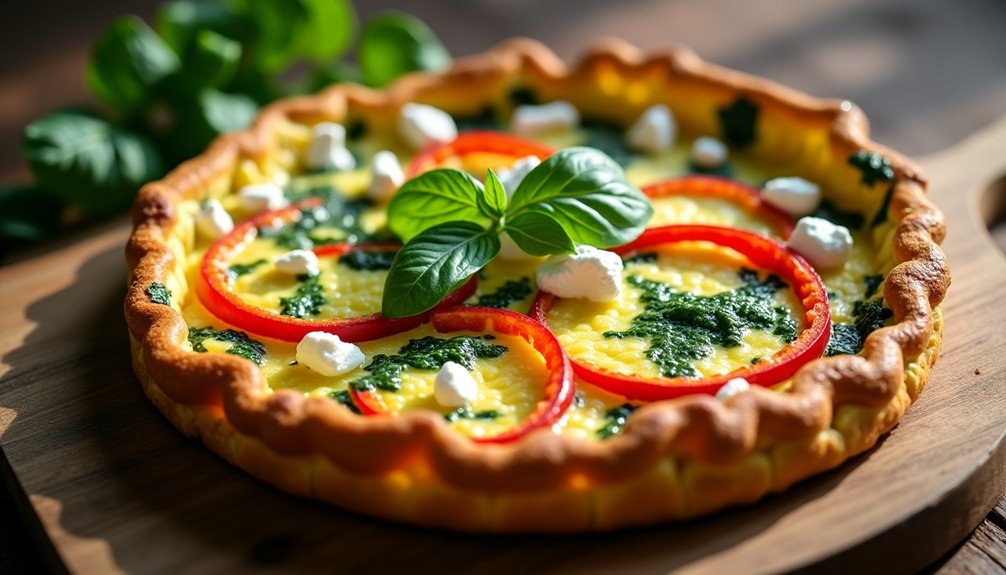An egg and veggie frittata is a colorful, protein-packed dish that combines eggs with your favorite vegetables. It's incredibly versatile, letting you mix and match ingredients like bell peppers, spinach, or onions for a nutrient-rich meal at any time. Start by whisking the eggs until fluffy, sauté your chosen veggies, then pour the eggs over them and bake until golden. This dish not only looks great but also tastes fantastic. Feel free to add cheese or fresh herbs for an extra flavor boost. If you keep going, you'll discover more tips on perfecting your frittata experience.
Key Takeaways
- Frittatas are a nutritious option, combining protein-rich eggs with various vegetables for a balanced meal any time of day.
- Key ingredients include eggs, cheese, and fresh vegetables, which enhance flavor and texture.
- Popular vegetables for frittatas include bell peppers, spinach, and onions, creating a colorful and nutrient-dense dish.
- Bake the frittata in a preheated oven for a fluffy texture, cooking until puffed and golden brown.
- Store leftovers in the fridge for 3-4 days or freeze for longer preservation, reheating gently to maintain fluffiness.
Benefits of Frittatas
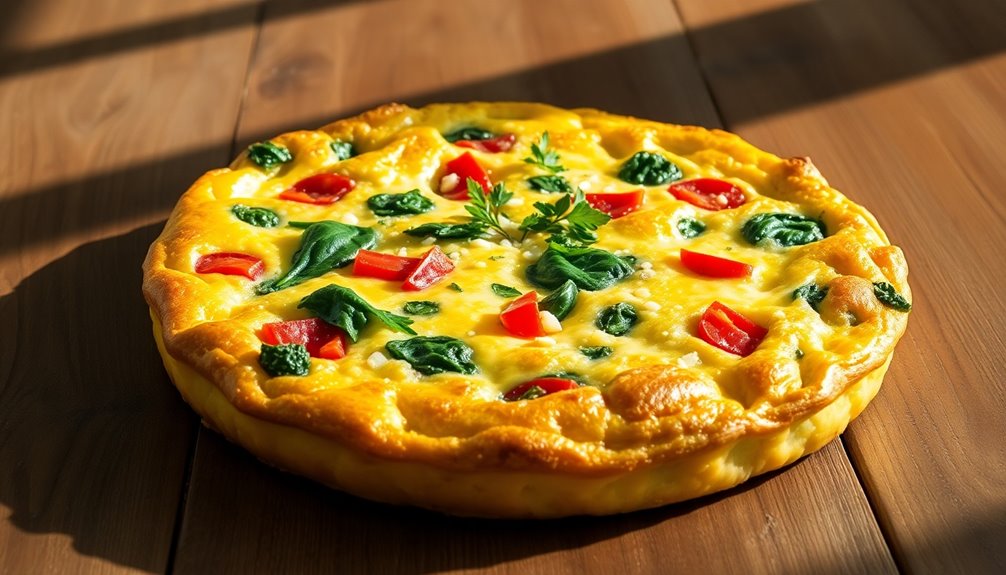
When you whip up a frittata, you're not just creating a delicious meal; you're also tapping into a world of nutritional benefits. Imagine this: a colorful medley of veggies mixed with protein-packed eggs, all baked to perfection. It's a dish that's not only satisfying but also brimming with essential nutrients. The health benefits are hard to ignore. Eggs provide high-quality protein, which is vital for muscle development and repair. They're also rich in vitamins like B12 and D, along with minerals like selenium, which helps boost your immune system.
One of the best things about frittatas is their versatility. You can throw in whatever vegetables you have on hand, making them a quick meal prep solution for busy days. Spinach, bell peppers, or even leftover roasted veggies all work beautifully. This means you can enjoy a nutritious meal without spending hours in the kitchen. Just sauté your chosen veggies, whisk your eggs, pour it all into a skillet, and let the oven do the rest.
You'll find that frittatas are perfect for any meal of the day. Serve them for brunch with friends, pack a slice for lunch, or enjoy a comforting dinner. This adaptability not only makes frittatas a staple in your meal rotation but also allows you to connect with loved ones over shared meals.
Essential Ingredients

A frittata's success rests on its essential components, which combine to create a flavorful and satisfying dish. The beauty of a frittata lies in its versatility, allowing you to customize it based on what you have on hand or your personal preferences. Let's explore the key elements that will elevate your frittata experience.
- Eggs: The foundation of any frittata, eggs provide richness and protein. Choose fresh, high-quality eggs for the best taste.
- Cheese: Adding cheese not only enhances creaminess but also introduces a delightful depth of flavor. Feta, cheddar, or mozzarella can work wonderfully.
- Seasonings: Don't overlook the importance of seasoning! Salt, pepper, and herbs like basil or thyme can transform your dish.
When it comes to ingredient substitutions, you can easily swap out items based on dietary preferences or pantry availability. For example, if you're dairy-free, consider using a plant-based cheese or nutritional yeast.
Cooking techniques also play an important role; sautéing your veggies first allows their flavors to develop, while baking the frittata guarantees even cooking. Experiment with different veggie combinations to find your perfect mix, whether it's a classic spinach and mushroom or a bold combination of bell peppers and zucchini.
With the right essential components, you'll create a frittata that not only satisfies your hunger but also brings everyone together at the table. Enjoy the process, and let your creativity shine!
Choosing Your Vegetables
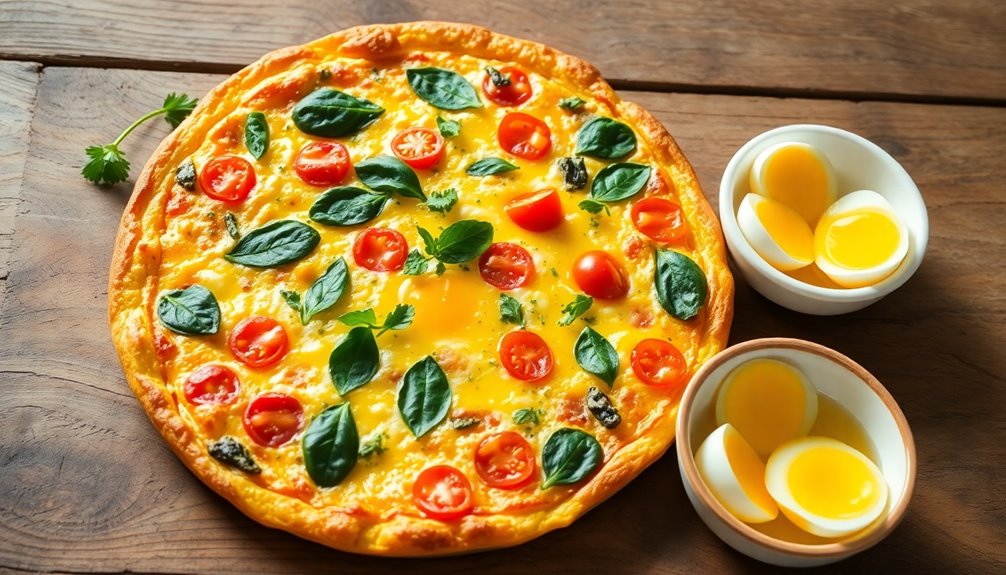
Choosing the appropriate vegetables for your frittata can elevate the dish from ordinary to extraordinary. When it comes to vegetable selection, think about what flavors and textures you enjoy. Start with the classics like bell peppers, spinach, and onions, but don't hesitate to branch out. Consider adding roasted zucchini, vibrant cherry tomatoes, or even a handful of fresh herbs. Each vegetable brings its unique taste, making your frittata a delightful experience.
Don't forget about color! Creating vibrant combinations not only makes your dish visually appealing but also packs in different nutrients. Imagine a frittata bursting with green spinach, red tomatoes, and yellow bell peppers. The contrast makes it more inviting and enjoyable to eat, enhancing the sense of community at your table.
Seasonal vegetables can also play a significant role in your selection process. Visit your local farmers' market to discover what's fresh and ripe. Seasonal produce often tastes better and can add a unique twist to your frittata.
Preparing the Egg Mixture
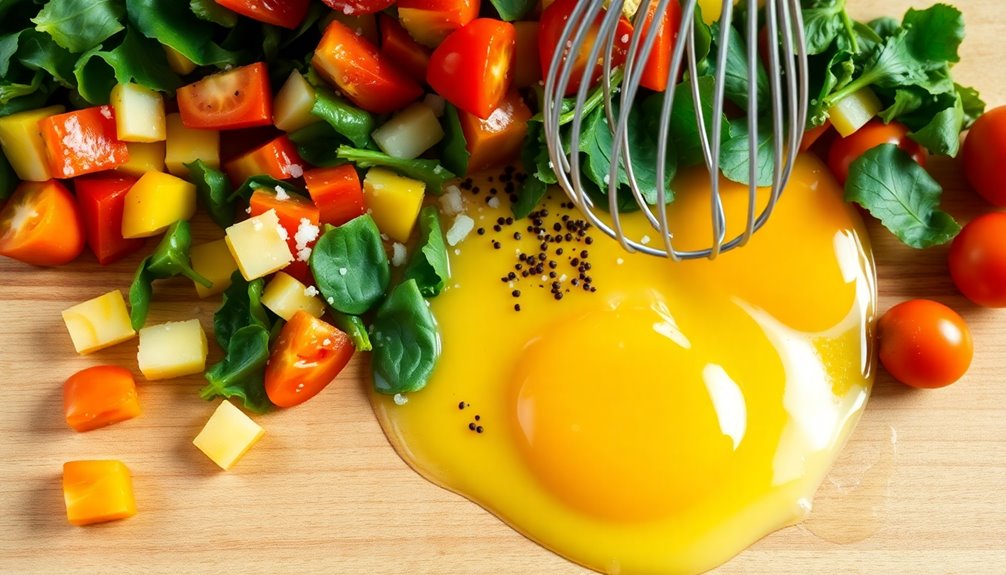
Crafting the perfect egg mixture is essential for a frittata that's both flavorful and satisfying. You'll want to start by whisking eggs in a large mixing bowl. Aim for about six large eggs, which should give you a hearty base. As you whisk, let your enthusiasm flow—this step isn't just about mixing; it's your chance to incorporate air, making the frittata light and fluffy.
Once the eggs are well-blended, it's time to enhance their flavor. Consider adding ingredients like:
- Fresh herbs like parsley or chives
- A splash of milk or cream for creaminess
- Salt and pepper to taste
Now, let's immerse ourselves in adding vegetables. You've already chosen your favorites, so chop them into bite-sized pieces. Think about how they'll complement the eggs; vibrant bell peppers, earthy spinach, or savory mushrooms each bring a unique twist.
Gently fold the chopped vegetables into the egg mixture, ensuring they're evenly distributed. This harmony of flavors will create a colorful, inviting dish that's perfect for sharing.
Cooking Techniques
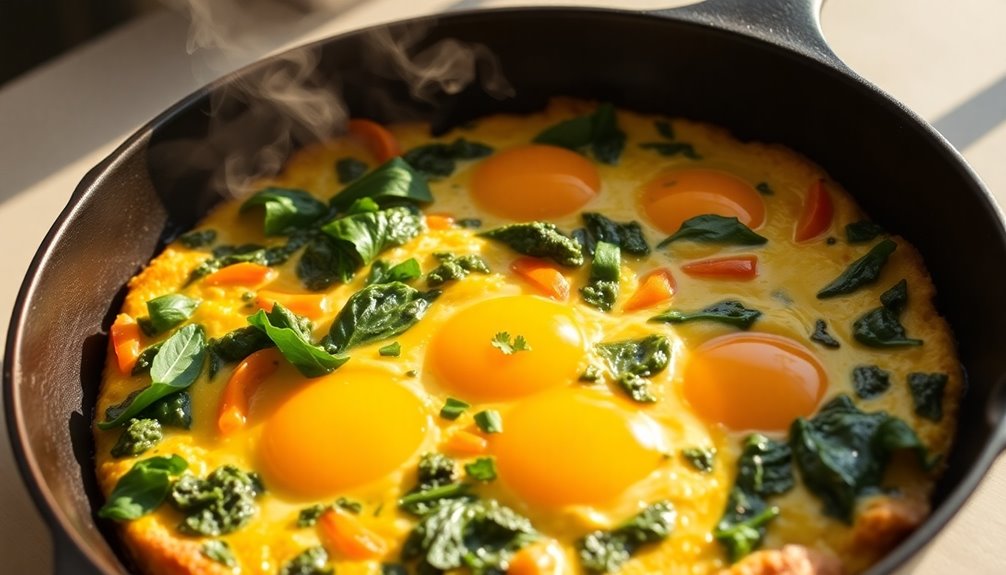
When it comes to cooking your frittata, mastering the right techniques can make all the difference in achieving that perfect, golden finish. First, you'll want to preheat your oven to 375°F (190°C). This step is vital for those delicious, fluffy results. While the oven warms up, grab a skillet that's safe for the oven, preferably cast iron, and heat it over medium heat. Add a splash of olive oil or a pat of butter to make certain your frittata doesn't stick.
Now, let's talk ingredient combinations. Sauté your chosen veggies, like spinach, bell peppers, or onions, until they're tender and aromatic. This not only enhances their flavors but also allows any excess moisture to evaporate, preventing a soggy frittata. Once your veggies are ready, pour in your whisked egg mixture, swirling it gently to distribute the ingredients evenly.
Here's where frittata cooking techniques come into play: as the edges start to set, use a spatula to gently push the cooked edges towards the center while tilting the pan to let the uncooked eggs flow to the edges. This way, you'll achieve an even cook. After about five minutes, transfer the skillet to your preheated oven. Bake until the frittata is puffed and golden, about 10-15 minutes.
With these techniques, you're not just cooking—you're creating a dish that brings everyone together. Enjoy your beautifully cooked frittata, and relish in the joy it brings to the table!
Flavor Enhancement Tips
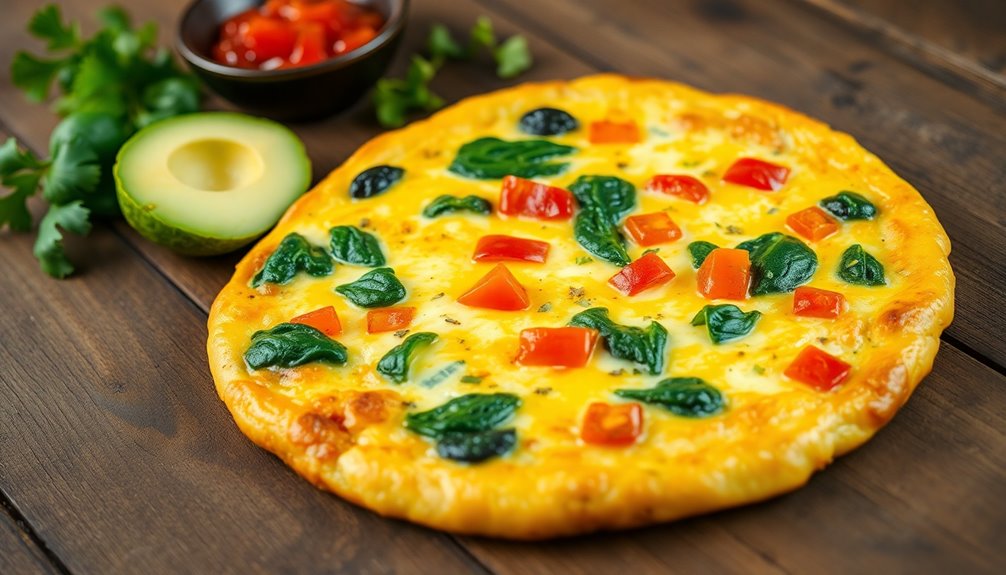
A well-made frittata can be a canvas for vibrant flavors, and there are plenty of ways to enhance its taste. Start by exploring various seasoning options that can elevate your dish. Think beyond the usual salt and pepper; try adding smoked paprika for a warm depth, or fresh herbs like basil or chives for a burst of freshness.
Ingredient pairing is essential too. Combining veggies like bell peppers with onions and spinach not only adds color but also creates a delicious symphony of flavors. Don't forget to balance textures—crunchy roasted veggies alongside creamy cheeses like feta or goat cheese can transform the experience.
Here are a few tips to help you enhance your frittata:
- Experiment with Cheese: Consider using a mix of cheeses for complexity. A sharp cheddar can offer a bold flavor, while a soft cheese can add creaminess.
- Incorporate Aromatics: Sautéing garlic or shallots before adding your eggs can infuse the dish with fragrance and richness.
- Finish with Freshness: A sprinkle of fresh herbs or a drizzle of olive oil just before serving can brighten up the overall taste.
Serving Suggestions

Serving a frittata can be just as invigorating as making it, and there are several delightful ways to present this versatile dish. To make your frittata the star of the meal, consider pairing it with a light, invigorating salad. A simple arugula salad with lemon vinaigrette complements the rich flavors of the eggs and veggies beautifully. If you're feeling adventurous, serve it alongside roasted tomatoes or sautéed mushrooms for an added depth of flavor.
For garnish ideas, fresh herbs like basil or parsley can elevate the dish visually and tastefully. A sprinkle of crumbled feta or goat cheese on top adds a creamy texture and a burst of flavor. You might also drizzle a little balsamic reduction for a touch of elegance.
When it comes to presentation tips, remember that first impressions matter. Use a vibrant plate to contrast the golden hues of your frittata. Slice it into wedges and arrange them in a fan shape for a visually appealing effect. You can also serve it in the skillet for a rustic touch, inviting your guests to help themselves.
Plating techniques can transform your frittata from ordinary to extraordinary. Consider layering ingredients or adding a side of colorful roasted vegetables for a touch of warmth. Finally, don't forget to provide a selection of dipping sauces, like salsa or a spicy aioli, to encourage your guests to customize their experience. Your frittata won't only taste delicious but also create a memorable dining experience.
Storage and Reheating
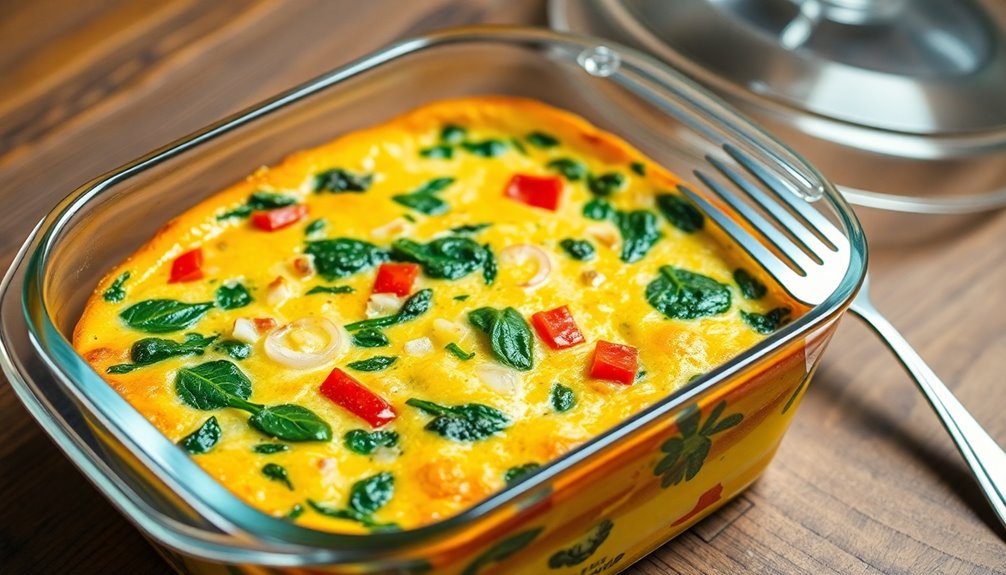
To maintain your egg and veggie frittata fresh and delicious, proper storage and reheating techniques are essential. You want to enjoy every bite, and with the right methods, you can guarantee your frittata stays tasty for days or even weeks.
When it comes to storage, consider these tips to keep your frittata at its best:
- Refrigeration: Store leftovers in an airtight container in the fridge; they'll stay fresh for about 3-4 days.
- Freezing tips: For long-term storage, slice the frittata into portions and wrap each piece tightly in plastic wrap before placing them in a freezer-safe bag. This helps maintain freshness while preventing freezer burn.
- Labeling: Don't forget to label your containers or bags with the date. This makes it easy to keep track of how long your frittata's been stored.
When it's time to enjoy your frittata again, you'll want to use effective reheating methods. For the best texture, avoid the microwave if you can. Instead, preheat your oven to 350°F (175°C) and place the frittata on a baking sheet for about 10-15 minutes. This will help preserve its fluffiness and prevent it from becoming rubbery. If you're in a hurry, the microwave works too—just cover it with a damp paper towel and heat in short intervals to avoid overcooking.
With these storage and reheating tips, you'll savor your frittata just as much as you did when it was freshly made!
Variations to Try
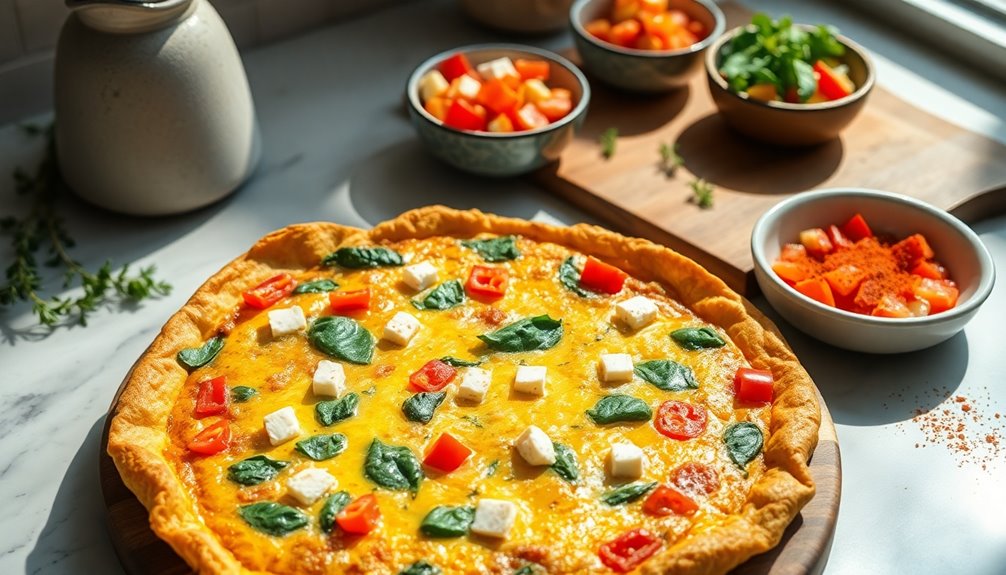
Exploring variations of your egg and veggie frittata can elevate your meals and keep things exciting in the kitchen. Don't hesitate to experiment with ingredient substitutions that reflect your taste and pantry staples. For instance, swap out spinach for kale or use zucchini instead of bell peppers. These small changes can bring a fresh twist to your dish while utilizing what you already have on hand.
Seasonal additions also play an essential role in transforming your frittata. Think about the vibrant produce available in different seasons. In the spring, consider adding asparagus and fresh herbs like dill or parsley.
Summer calls for ripe tomatoes and sweet corn, while fall is perfect for roasted butternut squash and sage. In winter, try incorporating hearty greens or root vegetables for a comforting, warming frittata.
Let your creativity flow by mixing in cheeses that complement your chosen ingredients. Feta offers a tangy kick, while cheddar adds a rich creaminess. Don't forget to season your frittata well; a pinch of smoked paprika or a dash of hot sauce can enhance the flavor profile.
Nutritional Information
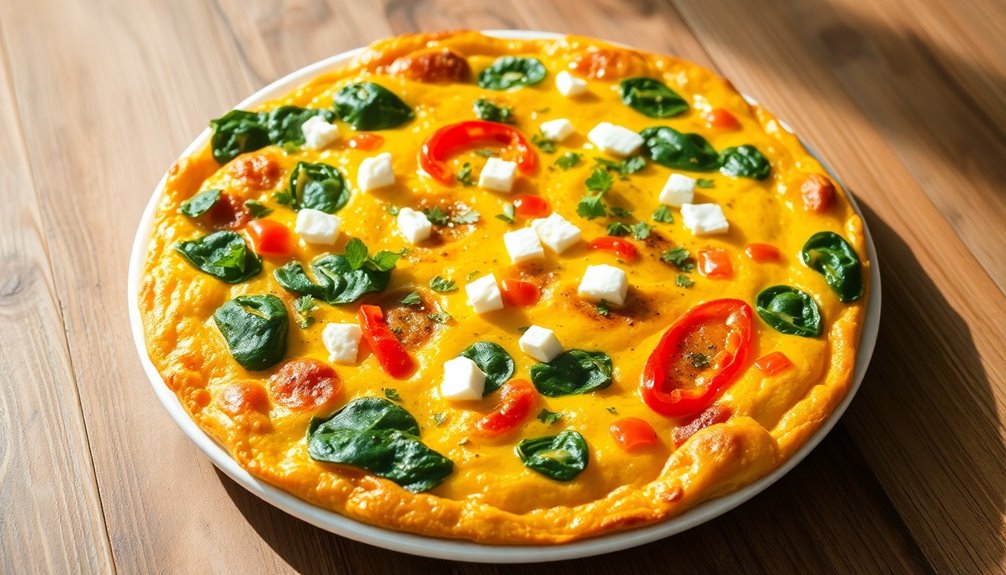
When you whip up a frittata packed with eggs and veggies, you're not just savoring a delicious meal; you're also nourishing your body with a variety of essential nutrients. This vibrant dish is a powerhouse of flavor and health, making it an ideal choice for any time of day.
One of the standout features of your egg and veggie frittata is its impressive protein content. Eggs are a fantastic source of high-quality protein, which is pivotal for muscle repair and growth. In fact, a typical serving can provide you with around 12 grams of protein, helping you feel fuller for longer.
Additionally, the calorie count of your frittata can be surprisingly low, especially when you load it with nutrient-dense vegetables like spinach, bell peppers, or zucchini. A serving can range from 200 to 300 calories, depending on the ingredients you choose, making it a satisfying meal without the excess.
Here's what makes your frittata a nutritional gem:
- Rich in vitamins: Leafy greens deliver vitamins A, C, and K, boosting your immune system.
- Healthy fats: Incorporating ingredients like cheese or avocado adds heart-healthy monounsaturated fats.
- Fiber-packed: Adding veggies contributes to your daily fiber intake, promoting digestive health.
Frequently Asked Questions
Can I Use Leftover Vegetables in My Frittata?
Absolutely, you can use leftover vegetables in your frittata! It's a fantastic way to reduce waste and create delicious frittata variations. Think about vegetable options like bell peppers, spinach, or zucchini that you've got on hand. Just chop them up and sauté before adding your eggs.
This not only enhances the flavor but also makes your frittata colorful and nutritious. You'll feel great knowing you've transformed leftovers into a delightful dish!
Is It Necessary to Beat the Eggs Before Adding Them?
You don't have to beat the eggs, but it's recommended for the best egg texture. When you whisk them, you create a light and airy mixture that helps the frittata rise beautifully.
Try a gentle mixing method—just enough to combine the yolks and whites without overdoing it. You'll find that a well-mixed egg base enhances the overall flavor and makes the dish feel more inviting and cohesive, inviting everyone to enjoy!
How Do I Know When the Frittata Is Fully Cooked?
To know when your frittata's fully cooked, pay attention to its texture and visual cues. Look for a firm, slightly puffed surface that isn't jiggly in the center.
The edges should be golden brown, while the top should be set and not shiny. You might also want to check with a toothpick; if it comes out clean, you're good to go! Trust your instincts, and you'll create a delicious dish everyone will love.
Can I Make a Frittata Without Eggs?
Absolutely, you can whip up a frittata without eggs! Explore vegan alternatives like silken tofu, chickpea flour, or aquafaba as egg substitutes.
Blend silken tofu with spices for a creamy base, or mix chickpea flour with water to create a batter. Add your favorite veggies for flavor and texture.
This way, you can still enjoy a hearty, satisfying dish while embracing a plant-based lifestyle. It's all about creativity in the kitchen!
What Kitchen Tools Do I Need to Make a Frittata?
To make a frittata, you'll need a few essential kitchen tools.
A non-stick skillet is great for the initial stovetop cooking, allowing you to easily perform the frittata flip.
If you prefer a casserole style, a baking dish works well for oven baking.
Don't forget a mixing bowl for your ingredients and a whisk to blend everything together smoothly.
With these tools, you're all set to create a delicious frittata that everyone will enjoy!
Conclusion
As you savor each bite of your colorful veggie frittata, imagine the vibrant hues of fresh vegetables dancing on your plate, each one bursting with flavor and nutrients. You've crafted a dish that not only nourishes your body but also delights your senses. Whether enjoyed warm from the oven or as a quick snack later, this versatile meal is a celebration of simplicity and health. So, embrace the joy of cooking and let your frittata inspire countless delicious moments.

